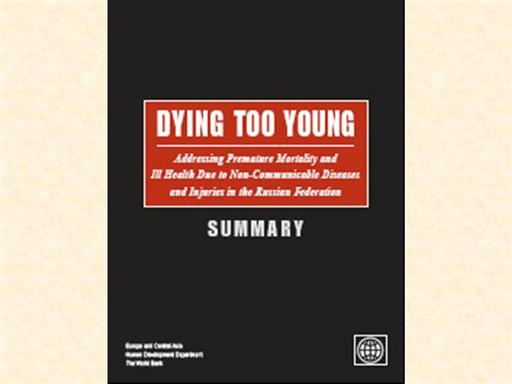| front |1 |2 |3 |4 |5 |6 |7 |8 |9 |10 |11 |12 |13 |14 |15 |16 |17 |18 |19 |20 |21 |22 |23 |24 |25 |26 |27 |28 |29 |30 |31 |32 |33 |34 |35 |36 |37 |38 |39 |40 |41 |42 |43 |44 |45 |46 |47 |48 |49 |50 |51 |52 |review |
 |
Despite economic growth in recent
years, Russia is facing phenomenal population decline, due in large part
to untimely deaths from heart disease, traffic accidents, and
alcoholism.
Life expectancy in Russia is 12
years less than life expectancy in the US.
Since 1992, the Russian population was reduced by 6 million people, and if current low fertility and high mortality trends continue, the Russian Federation will lose approximately 18 million people by 2025. As a result, Russia will go from being the 6th-most-populous country in the world to being the 17th.
Russian working-age men are
particularly at risk. If current ill health and disability are
considered, the healthy life expectancy of Russian males will fall to 53
years.
http://siteresources.worldbank.org/INTECA/Resources/Dying_too_Young_Summary_UPDATED_Oct_19.pdf
– Summary of World Bank Report, 2005, Accessed December 30,2008.
World Bank publication,
Dying Too Young – Addressing Premature
Mortality and Ill Health Due To
Non-Communicable Diseases and Injuries in the Russian Federation
(2005) prepared by Patricio V. Marquez,
Lead Health Specialist, Europe and Central Asia Region
(ECA), The World Bank, with contributions
from:
Marc Suhrcke and Lorenzo Rocco, World
Health Organization (WHO) European Office for
Investment for Health and Development,
Venice; Martin McKee and Dave Leon, London School of
Hygiene and Tropical Medicine; Jill
Farrington and Anatolyi Nosikov, WHO Office for Europe,
Copenhagen; Tiina Laatikainen, National
Public Health Institute of Finland; Kirill Danishevski,
Moscow Medical Academy; and from members
of the World Bank Russia Health Team: Anne
Margreth Bakilana, Tatyana Loginova,
Willy De Geyndt, Edward Frid, John C. Langenbrunner,
Ginny Hsieh and Alberto Gónima.
The authorities of the Russian Ministry
of Health and Social Development provided overall guidance
and advice under the leadership of Deputy
Minister V. Starodubov and Department Director, Dr.R.
Khalfin. Professor R. G. Oganov of the
Russian State Research Center of Preventive Medicine and
his team provided advice, information,
and assessments conducted by Russian researchers.
Additional contributions were made by the
team of the North Karelia Project and the National Public
Health Institute of Finland, under the
leadership of Professor Pekka Puska, who advised on the lessons
learned from the Finnish experience
during a visit to Joensuu and Helsinki in April 2005.
The report benefited from comments and
advice from World Bank managers and technical specialists:
Kristalina I. Georgieva, Charles Griffin,
Armin Fidler, Enis Baris, Edmundo Murrugarra,
Christoph Kurowski, Cem Mete, John
Litwack, Maria Gracheva, Joy de Beyer, Ben Eijbergen,
Gillette Conner, Dorothee Eckertz, Maris
Jesse, Derek Yach, Yale University School of Medicine;
and Oscar Echeverri, as well as from
Mikko Vienonen, Country Director, WHO Office, Moscow,
Brook Horowitz, The Prince of Wales
International Business Leaders Forum, London, and Carlos
Santos-Burgoa, Mexican Health
Secretariat.
Beth Goodrich edited the report, and
Anahit Poghosyan was responsible for its production.
The report’s findings and recommendations
were presented at a workshop organized by the
MOHSD in Moscow on June 14-15, 2005.
The summary was prepared by Patricio V.
Marquez with editorial support from Merrell J. Tuck-
Primdahl and Christina Anna Lakatos, ECA
External Affairs, The World Bank.
|